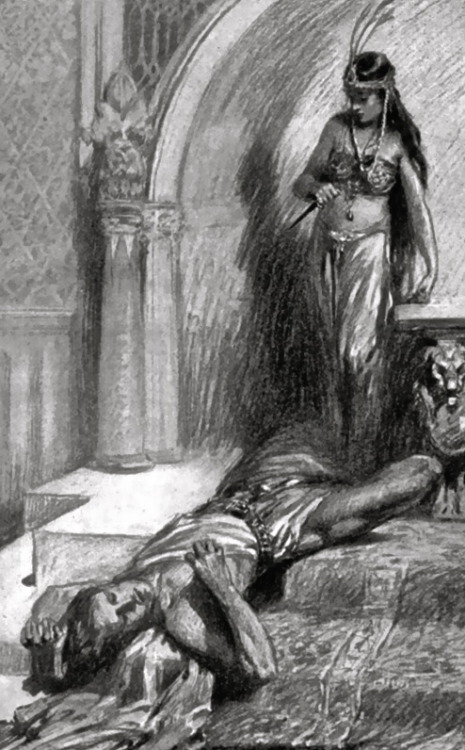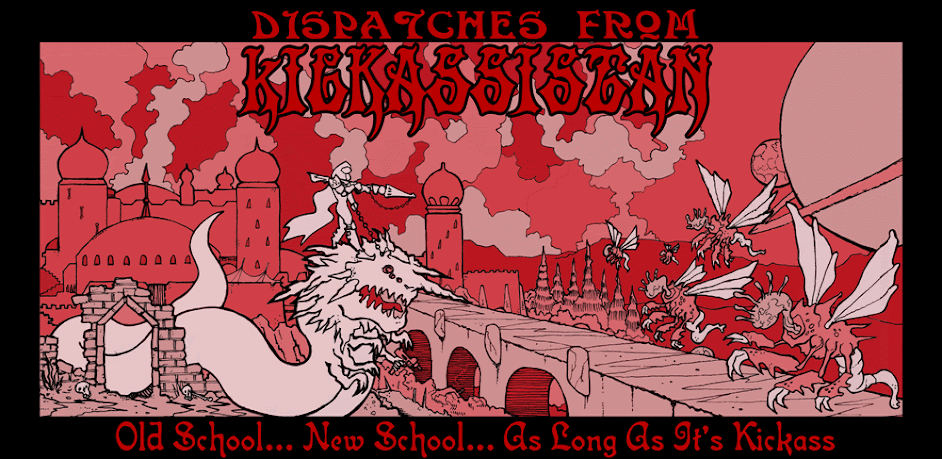It's been a long time since I've written any Stupid Dice Tricks. Man, do I miss it. I haven't had much need for new stupid dice tricks for awhile, so I've tapered off not just sharing them, but working them out as well. (It may be interesting to note for newbies to the Dispatches and Metal Gods zine stuff that the d11 mechanic that a lot of folks seem to applaud me for was originally written down as a stupid dice trick.) Lately, my gaming interests seem to have solidified around three core OSR-style games: Dungeon Crawl Classics, Astonishing Swordsmen & Sorcerers of Hyperborea and Adventurer Conqueror King. All of these games, at least the way I use them, have a similar feeling of grandiose Swords & Sorcery abandon that I crave in my games without any of the post-genre pseudo-medievalism that I eschew (again, at least the way I use them; ACKS could get kind of pseudo-medieval-y if you let it).
 All of these systems have unique takes on task resolution that intrigue me. DCC uses the "d20 system"-style "roll a d20, roll high, get equal to or above a number declared by the Judge and you succeed" method. ACKS uses a "d20, roll high" method, but the target number is set by class features & proficiencies (and is thus baked into the character, rather than up to Judge discretion) with no bonuses for ability scores and the like. ASSH usually uses a d6 with Judge-assigned target number, usually listed in the number of facets that would account for an actual success (which I like because the roll low people can just keep it the way it is while the roll high people reinterpret it to descend from 6 instead of going up from 1).
All of these systems have unique takes on task resolution that intrigue me. DCC uses the "d20 system"-style "roll a d20, roll high, get equal to or above a number declared by the Judge and you succeed" method. ACKS uses a "d20, roll high" method, but the target number is set by class features & proficiencies (and is thus baked into the character, rather than up to Judge discretion) with no bonuses for ability scores and the like. ASSH usually uses a d6 with Judge-assigned target number, usually listed in the number of facets that would account for an actual success (which I like because the roll low people can just keep it the way it is while the roll high people reinterpret it to descend from 6 instead of going up from 1).
DCC's method of task resolution (d20 system style) is pretty well documented and is modified by character ability, so modelling out exact parity between it and systems like these can be difficult since character traits like Ability Scores don't really play into the dice rolls. Further, ACKS uses some odd but discrete success intervals, so most rolls are not on a strict sliding scale. For example, lots of tasks are resolved on a roll of 18+ (or "throw" of 18+ if you want to use Autarch's actual terminology) or 14+ or 11+. These large and inconsistent chunks seemed odd to me. Sometimes, Autarch will muddy the waters themselves by saying things like an open doors check requires an 18+, but that every point of Strength bonus improves the chance by four. Now, you could simply add four to your roll, or you could just take that off the target number. 18+ becomes 14+ (one of Autarch's commonly used target values) with a 13 to 15 Strength, but with a 16-17, it becomes 10+ (which doesn't fit the model). When I started looking more closely into this, I realized an interesting fact: Autarch's 18/14/11 scheme fits the rough probabilities of a d6, in that an 18+ is roughly the same probability of 1-in-6 (1:6; Autarch is 15%, 1:6 is 16.67%), 14+ is roughly the same as 2-in-6 (2:6; Autarch is 35%, 2:6 is 33.33%) and so on.
And thus the idea of a Trans-System Task Resolution Rosetta Stone popped into my brain. The math is really quite easy, so I decided to collate it in one place for you to use however and whenever you thought wise. Here it is:
I hope this makes sense. Basically, it states that something that is a 1:6 chance in ASSH is roughly the same probability as something that requires an 18+ d20 roll in ACKS. DCC doesn't have any direct analogs to the ASSH and ACKS probabilities, but I included the standard DCC Difficulty Classes where applicable. You will notice some slight differences in probability percentages between ASSH & ACKS, but that's because of the granularity of the dice in question. Each facet on a d6 has a 16.67% of being landed on, whereas each facet of a d20 has a 5% chance of being rolled. It's just the way the math pans out. You'll also notice that I include nothing between a DC 5 and a DC 10 on the DCC side of this comparison; that's not to say you cannot use, say, a DC 7 for anything in DCC, but rather that DCC itself uses only the DC 5, 10, 15 & 20 as its stated DCs.
Please note that I understand this breakdown is not the be all and end all of probabilities for ASSH & ACKS. There are other circumstances in both games where probabilities will cut between these broad categories, most notably with thief skills (which get really exciting in ASS; hello, d12!). Most task resolution, however, can be handled with the probability break downs as given, however, and should serve your purposes most of the time; however, a big "X:12 vs. d20" chart like the one above is probably somewhere in the offing as well. It'd just be fun to make.
 All of these systems have unique takes on task resolution that intrigue me. DCC uses the "d20 system"-style "roll a d20, roll high, get equal to or above a number declared by the Judge and you succeed" method. ACKS uses a "d20, roll high" method, but the target number is set by class features & proficiencies (and is thus baked into the character, rather than up to Judge discretion) with no bonuses for ability scores and the like. ASSH usually uses a d6 with Judge-assigned target number, usually listed in the number of facets that would account for an actual success (which I like because the roll low people can just keep it the way it is while the roll high people reinterpret it to descend from 6 instead of going up from 1).
All of these systems have unique takes on task resolution that intrigue me. DCC uses the "d20 system"-style "roll a d20, roll high, get equal to or above a number declared by the Judge and you succeed" method. ACKS uses a "d20, roll high" method, but the target number is set by class features & proficiencies (and is thus baked into the character, rather than up to Judge discretion) with no bonuses for ability scores and the like. ASSH usually uses a d6 with Judge-assigned target number, usually listed in the number of facets that would account for an actual success (which I like because the roll low people can just keep it the way it is while the roll high people reinterpret it to descend from 6 instead of going up from 1).DCC's method of task resolution (d20 system style) is pretty well documented and is modified by character ability, so modelling out exact parity between it and systems like these can be difficult since character traits like Ability Scores don't really play into the dice rolls. Further, ACKS uses some odd but discrete success intervals, so most rolls are not on a strict sliding scale. For example, lots of tasks are resolved on a roll of 18+ (or "throw" of 18+ if you want to use Autarch's actual terminology) or 14+ or 11+. These large and inconsistent chunks seemed odd to me. Sometimes, Autarch will muddy the waters themselves by saying things like an open doors check requires an 18+, but that every point of Strength bonus improves the chance by four. Now, you could simply add four to your roll, or you could just take that off the target number. 18+ becomes 14+ (one of Autarch's commonly used target values) with a 13 to 15 Strength, but with a 16-17, it becomes 10+ (which doesn't fit the model). When I started looking more closely into this, I realized an interesting fact: Autarch's 18/14/11 scheme fits the rough probabilities of a d6, in that an 18+ is roughly the same probability of 1-in-6 (1:6; Autarch is 15%, 1:6 is 16.67%), 14+ is roughly the same as 2-in-6 (2:6; Autarch is 35%, 2:6 is 33.33%) and so on.
And thus the idea of a Trans-System Task Resolution Rosetta Stone popped into my brain. The math is really quite easy, so I decided to collate it in one place for you to use however and whenever you thought wise. Here it is:
I hope this makes sense. Basically, it states that something that is a 1:6 chance in ASSH is roughly the same probability as something that requires an 18+ d20 roll in ACKS. DCC doesn't have any direct analogs to the ASSH and ACKS probabilities, but I included the standard DCC Difficulty Classes where applicable. You will notice some slight differences in probability percentages between ASSH & ACKS, but that's because of the granularity of the dice in question. Each facet on a d6 has a 16.67% of being landed on, whereas each facet of a d20 has a 5% chance of being rolled. It's just the way the math pans out. You'll also notice that I include nothing between a DC 5 and a DC 10 on the DCC side of this comparison; that's not to say you cannot use, say, a DC 7 for anything in DCC, but rather that DCC itself uses only the DC 5, 10, 15 & 20 as its stated DCs.
Please note that I understand this breakdown is not the be all and end all of probabilities for ASSH & ACKS. There are other circumstances in both games where probabilities will cut between these broad categories, most notably with thief skills (which get really exciting in ASS; hello, d12!). Most task resolution, however, can be handled with the probability break downs as given, however, and should serve your purposes most of the time; however, a big "X:12 vs. d20" chart like the one above is probably somewhere in the offing as well. It'd just be fun to make.

